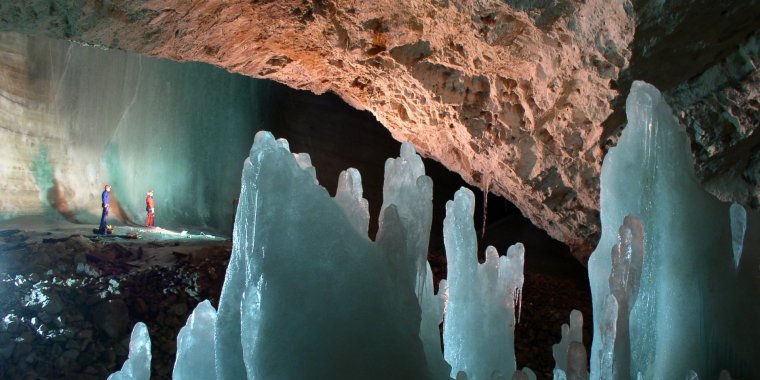| News / World News |
Ice cave in Transylvania yields window into region's past
Ice cores drilled from a glacier in a cave in Transylvania offer new evidence of how Europe's winter weather and climate patterns fluctuated during the last 10,000 years, known as the Holocene period.

Ice formations and an ice cliff in the "Small Reserve," a chamber on one side of the ice cliff. ![]()
The cores provide insights into how the region's climate has changed over time. The researchers' results, could help reveal how the climate of the North Atlantic region varies on long time scales.
Researchers from the Emil Racoviță Institute of Speleology in Cluj-Napoca, Romania, and University of South Florida's School of Geosciences gathered their evidence in the world's most-explored ice cave and oldest cave glacier, hidden deep in the heart of Transylvania in central Romania.
With its towering ice formations and large underground ice deposit, Scărișoara Ice Cave is among the most important scientific sites in Europe.
Over the last 10,000 years, snow and rain dripped into the depths of Scărișoara, where they froze into thin layers of ice containing chemical evidence of past winter temperature changes.
Until now, scientists lacked long-term reconstructions of winter climate conditions. That knowledge gap hampered a full understanding of past climate dynamics.
Reconstructions of Earth's climate record have relied largely on summer conditions, charting fluctuations through vegetation-based samples, such as tree ring width, pollen and organisms that thrive in the warmer growing season.
Located in the Apuseni Mountains, the region surrounding the Scărișoara Ice Cave receives precipitation from the Atlantic Ocean and the Mediterranean Sea and is an ideal location to study shifts in the courses storms follow across East and Central Europe.
Radiocarbon dating of minute leaf and wood fragments preserved in the cave's ice indicates that its glacier is at least 10,500 years old, making it the oldest cave glacier in the world and one of the oldest glaciers on Earth outside the polar regions.
From samples of the ice, the researchers were able to chart the details of winter conditions growing warmer and wetter over time in Eastern and Central Europe. Temperatures reached a maximum during the mid-Holocene some 7,000 to 5,000 years ago and decreased afterward toward the Little Ice Age, 150 years ago.
A major shift in atmospheric dynamics occurred during the mid-Holocene, when winter storm tracks switched and produced wetter and colder conditions in northwestern Europe, and the expansion of a Mediterranean-type climate toward southeastern Europe.
Warming winter temperatures led to rapid environmental changes that allowed the northward expansion of Neolithic farmers toward mainland Europe, and the rapid population of the continent. (NSF)
YOU MAY ALSO LIKE





